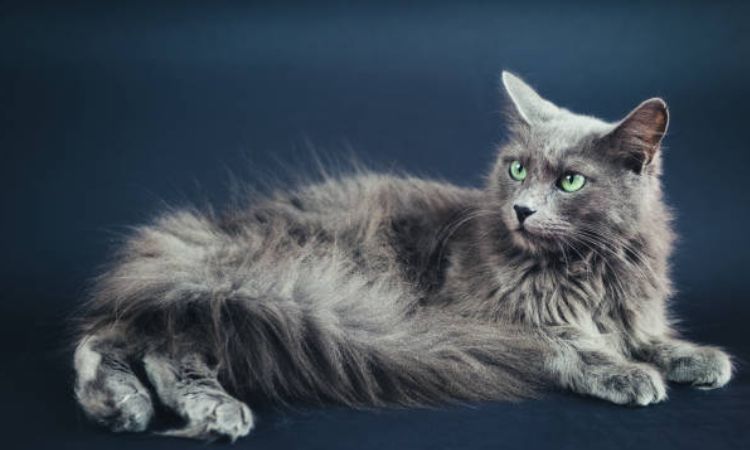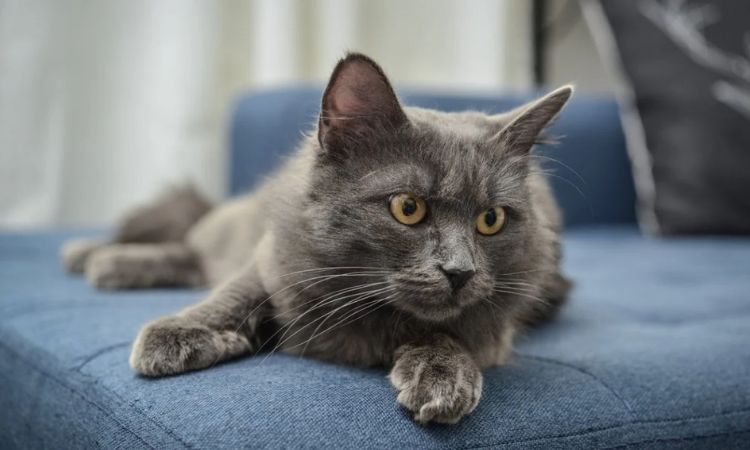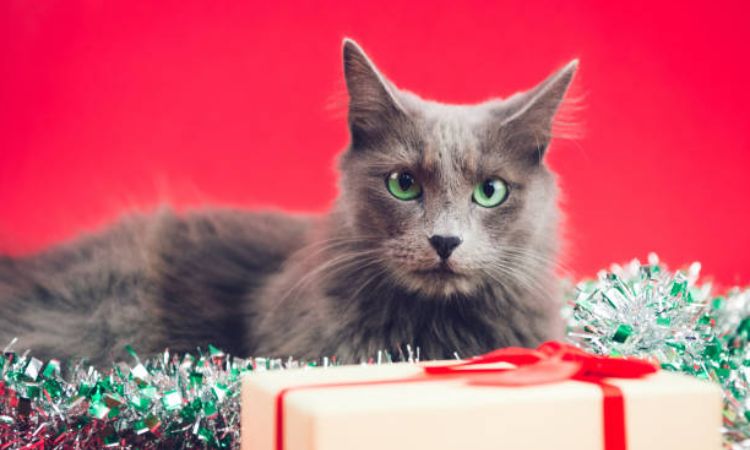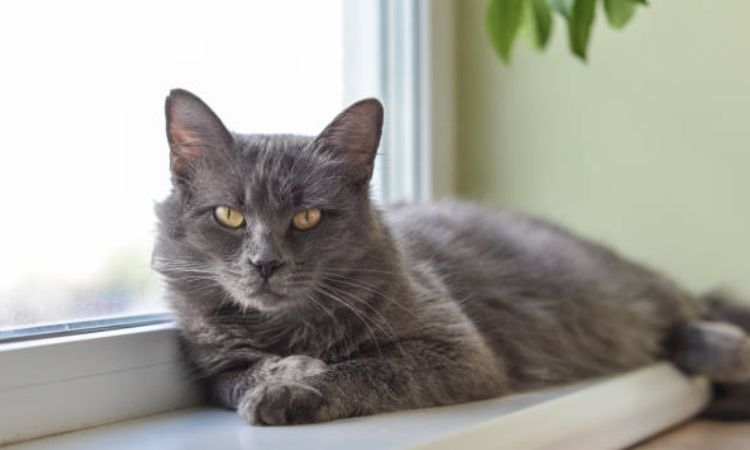With their shimmering blue-gray coats and piercing green eyes, Nebelung cats look like something out of a fairytale. This rare and graceful breed is often described as mysterious, but behind their elegant appearance lies a loyal, affectionate, and gentle companion.
Because Nebelungs are so uncommon, many people have questions about their personality, care needs, and even whether they’re truly hypoallergenic. In this guide, we’ll cover everything you need to know about the Nebelung from their history and temperament to price and where you might find one.
Understanding the Mysterious “Creature of the Mist” (Nebelung)
The Nebelung is a rare and elegant pedigree breed that first emerged in the United States during the 1980s. Its name, derived from the German word “Nebelung” meaning “creature of the mist” or “fog,” perfectly reflects the breed’s ethereal appearance. With a shimmering, silvery-blue coat, luminous green eyes, and a long, slender body, the Nebelung looks almost otherworldly—earning it a reputation as one of the most striking cats in the world.

Developed by Cora Cobb of Nebelheim Cattery, the breed traces its foundation back to two cats, Siegfried and Brunhilde, who combined the characteristics of the Russian Blue with a semi-longhaired coat. As a result, the Nebelung is often described as the “long-haired Russian Blue.” While closely related to its shorthaired cousin, the Nebelung has its own distinct identity, recognized by cat associations like TICA (The International Cat Association) for its unique charm and beauty.
Are Nebelung Cats Rare?
Yes, Nebelung cats are considered one of the rarest modern pedigree breeds.
Here’s why:
- Recent history – The breed only originated in the 1980s, making it relatively new compared to centuries-old breeds like the Persian or Siamese.
- Limited breeding stock – Nebelungs were developed from Russian Blue bloodlines with the addition of the longhair gene, and very few breeders continue the line today.
- Small global population – In the U.S. and Europe, only a handful of kittens are registered each year. For example, in the U.K. fewer than five Nebelung kittens were born annually in recent years.
- Registry data – TICA reported just over 400 Nebelung cats registered between 1979 and 2013. Even now, the breed is still absent from many registries’ active breeder lists.
Because of this scarcity, Nebelung cats are rarely found in shelters, and when available from reputable breeders, they are often priced higher than more common purebreds.
Nebelung Cat Price Guide: How Much Does a Kitten Cost?

Nebelung Kitten Price Range
Nebelungs are among the rarest cat breeds in the world, and their scarcity directly affects their price. On average, a Nebelung kitten from a reputable breeder ranges between $600 and $1,200, though prices can climb higher depending on specific factors.
Several elements influence the cost of a Nebelung kitten:
- Bloodline and Pedigree: Kittens from award-winning or champion lines tend to be more expensive.
- Breeder Reputation: Established breeders with proper registrations (TICA, ACFA, WCF, etc.) often charge a premium.
- Included Health Measures: Some breeders include spay/neuter procedures, vaccinations, microchipping, and early vet care in the price, adding value to the purchase.
- Geographical Location: Availability in certain countries or regions may also affect pricing.
Adoption vs. Breeder Cost
Because Nebelungs are so rare, they are seldom found in shelters or rescues. Adoption fees for cats in general are usually much lower—ranging from $50 to $200—but locating a true Nebelung in a shelter is extremely unlikely. Occasionally, long-haired Russian Blue mixes may appear in adoption listings, which can provide a similar aesthetic and temperament at a fraction of the cost.
For those seeking a purebred Nebelung, purchasing through a verified breeder remains the most reliable option, albeit more expensive. Patience is often required due to limited litters and waiting lists.
The True Cost of Ownership (Beyond Purchase Price)
Owning a Nebelung is more than the initial price of a kitten. Prospective owners should consider ongoing expenses, which can add up quickly:
- Initial Setup Costs:
- Food and water bowls
- Litter box and litter
- Cat carrier for trips
- Scratching posts or climbing trees
- Bed, toys, and grooming supplies
- Recurring Costs:
- Food: High-quality, protein-rich cat food (wet or dry)
- Grooming: Weekly brushing for their semi-long, silver-tipped coat
- Veterinary Care: Routine check-ups, vaccinations, and preventive medications
- Optional: Pet insurance to cover unexpected health issues
Overall, while the upfront cost of a Nebelung kitten may be significant, budgeting for proper care ensures your Nebelung remains healthy, happy, and thriving for 15–18 years or more.
The Nebelung Hypoallergenic Myth: Fact vs. Fiction
When it comes to cat breeds, few things stir more debate than the issue of whether or not a breed is “hypoallergenic.” Nebelung cats, with their long, silky coats and graceful demeanor, are often mistakenly thought of as hypoallergenic. But is this just a myth, or is there some truth behind it? Let’s take a closer look at the facts.
What Makes a Cat Hypoallergenic?
Before diving into the Nebelung’s allergenic properties, it’s essential to understand what “hypoallergenic” really means in the context of cats. There’s no such thing as a completely hypoallergenic cat, but some breeds produce fewer allergens than others. The main culprits for allergic reactions to cats are proteins found in the cat’s skin cells (dander), saliva, and urine. When cats groom themselves, the proteins in their saliva can stick to their fur and be released into the air as the cat sheds.
Some cat breeds, like the Sphynx (a hairless breed), produce less dander because they don’t have a thick coat to trap the proteins. Others, like the Russian Blue, are thought to produce fewer allergens, which might be why the Nebelung is sometimes mistakenly labeled as hypoallergenic.
The Nebelung Cat’s Coat and Allergen Production
Nebelungs have medium-length, soft, double-layered coats that are often blue in color with silver-tipped guard hairs. While their fur might look sleek and shiny, it still sheds and collects dander, just like any other cat breed. In fact, because of their thick, dense coats, Nebelungs tend to shed more during certain seasons, spreading dander around the home.
Despite being compared to the Russian Blue breed (which is sometimes considered less allergenic), Nebelungs still produce the same types of allergens that can trigger reactions in sensitive individuals. The presence of longer fur only exacerbates the situation, as more fur means more shedding, and more shedding means more dander.

Why Do People Think Nebelungs Are Hypoallergenic?
There’s a common misconception that any long-haired breed must be hypoallergenic, but this is not the case. The myth about Nebelungs being hypoallergenic likely stems from their resemblance to the Russian Blue, which is sometimes considered one of the “less allergenic” breeds due to its short coat and lower shedding. However, being a long-haired breed, Nebelungs do not benefit from these potential allergenic advantages.
Additionally, Nebelungs are known for being somewhat low-shedding compared to other long-haired breeds like Persians. While they do shed less frequently than, say, a Maine Coon, they still produce enough dander to trigger allergic reactions in sensitive individuals.
Can People with Allergies Live with Nebelungs?
If you have mild allergies to cats, it’s possible that you may tolerate a Nebelung better than other long-haired breeds. Some allergy sufferers find they can manage with certain breeds if they take precautions such as regular cleaning, using air purifiers, and bathing the cat regularly. However, those with severe allergies to cats will likely still experience reactions, as no cat is truly hypoallergenic.
If you’re considering adopting a Nebelung and have a history of cat allergies, it’s a good idea to spend some time around the breed before making a decision. Try visiting a breeder or an owner who has a Nebelung to see how your body reacts. This will give you a better idea of whether or not you can live with the breed without suffering from severe allergic symptoms.
Where to Find a Nebelung Kitten for Sale or Adoption
Reputable Nebelung Cat Breeders
If you choose to buy a Nebelung kitten, it’s crucial to work with a responsible, TICA-registered breeder. TICA (The International Cat Association) maintains breeder directories that list those who meet the organization’s standards for health, genetics, and breeding practices.
When searching for a breeder:
- Verify credentials: Ensure the breeder is registered with reputable cat associations such as TICA, ACFA, or WCF.
- Visit the cattery in person: Observing the environment allows you to see how cats are raised, assess their living conditions, and interact with kittens.
- Ask for health guarantees and records: A responsible breeder will provide vaccinations, health checks, and documentation for both kittens and parent cats.
- Request references: Previous buyers can provide insight into the breeder’s reputation, kitten quality, and after-sale support.
A good breeder prioritizes the health and temperament of their kittens, socializes them from a young age, and is willing to answer all questions openly.
Nebelung-Specific Rescues and Adoption
Though rare, Nebelung cats occasionally appear in adoption centers or through breed-specific rescues. Platforms like Petfinder, Adopt-a-Pet, and local feline rescue organizations can be valuable resources. Some Nebelung enthusiasts and Russian Blue rescues also network to find these cats homes, as their physical similarity can make them easier to place through breed-specific channels.
Caution: Many long-haired blue cats are misidentified as Nebelungs. Mixed-breed cats may resemble the breed but lack purebred characteristics. Always confirm with a knowledgeable breeder or rescue before assuming the kitten is a true Nebelung.
What to Ask a Nebelung Breeder
Before committing, prepare a list of questions to ensure you’re adopting a kitten responsibly:
- Health testing: Have the parents been screened for genetic conditions common to Nebelungs?
- Vaccinations and veterinary care: Are the kittens up-to-date on shots, deworming, and veterinary exams?
- Parent cats’ temperament: What are the personalities of the mother and father? Temperament often carries over to kittens.
- Early socialization: How are the kittens handled and introduced to humans? Are they accustomed to normal household noises and interactions?
- Breeding philosophy: Ask about the breeder’s goals, experience, and breeding practices to ensure they prioritize the breed’s well-being over profit.
Adopting or purchasing a Nebelung kitten is a long-term commitment, and careful planning ensures you bring home a cat with the right health, personality, and support for a happy life.
Nebelung Cat Temperament and Care
Temperament and Personality
Nebelungs are known for their quiet elegance, intelligence, and loyalty. They are affectionate with their chosen humans and often form strong bonds with one or two family members. While they are loving and playful, they tend to be shy or cautious around strangers and may initially hide when new people visit.
These cats thrive in calm, stable households. They enjoy gentle play, interactive toys, and mental stimulation such as puzzle feeders or training sessions. Despite their reserved nature, Nebelungs are curious and enjoy exploring their environment at their own pace. They are also known to be “dog-like” in loyalty, often following family members from room to room and seeking companionship.
Nebelungs usually get along with other calm cats and well-behaved, cat-friendly dogs. They may be hesitant around young children or loud, boisterous pets, so introductions should be gradual and supervised. These cats appreciate routines, and sudden changes in their environment can lead to stress or anxiety.

Grooming and Coat Care
Nebelungs have a medium-long, double-layered coat that is silky, soft, and tipped with silver. While they do not shed excessively, their coat benefits from weekly brushing to prevent tangles and keep the fur smooth. Extra attention may be needed during seasonal coat changes.
Other grooming essentials include:
- Nail trimming: Every few weeks or monthly, depending on activity levels.
- Ear care: Check ears regularly and clean gently with cat-safe solutions if needed.
- Dental hygiene: Brush teeth a few times a week using cat-safe toothpaste.
Nutrition
A balanced diet is crucial to keep a Nebelung healthy and active. High-quality, high-protein food is recommended, with moderate fat and low carbohydrates. Kittens require more frequent, smaller meals, while adults generally thrive on two meals per day. Avoid overfeeding, as Nebelungs can become overweight if their portion sizes aren’t monitored. Adding Omega fatty acids to their diet can help maintain a glossy, healthy coat.
Exercise and Enrichment
Although calm, Nebelungs are active and intelligent. They benefit from toys, climbing posts, and interactive play sessions that stimulate both body and mind. Many enjoy exploring a secure cat run or learning tricks with positive reinforcement. Providing regular exercise helps prevent boredom and supports physical and mental health.
Health and Vet Care
Nebelungs are generally healthy and long-lived, with an average lifespan of 15–18 years. However, like all cats, they may develop conditions such as kidney issues, digestive sensitivities, asthma, or obesity. Regular veterinary checkups, vaccinations, and preventive care are essential. Observing changes in behavior, appetite, or grooming habits can help detect potential health problems early.
Nebelung cats combine rare beauty, gentle intelligence, and loyal companionship, making them a unique addition to the right home. While their limited numbers and specialized care make them a commitment, understanding their temperament, grooming needs, and true costs ensures prospective owners are prepared to provide a loving, stable environment where these misty-blue cats can thrive.






